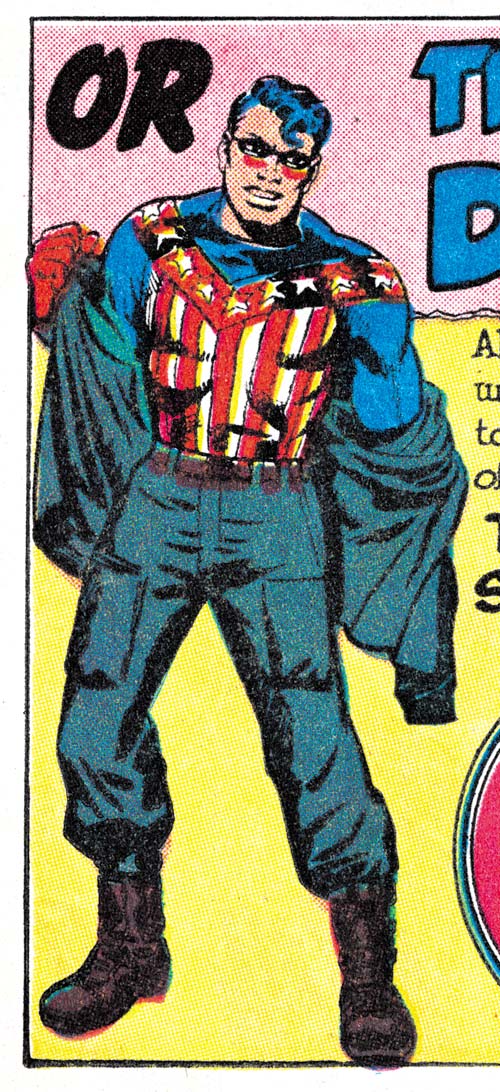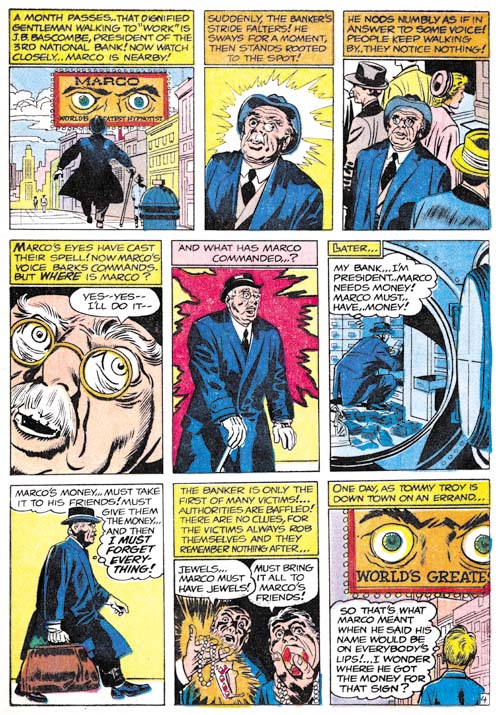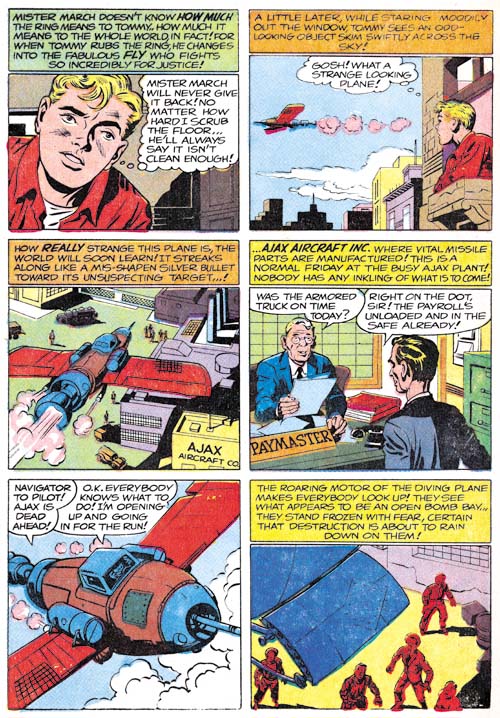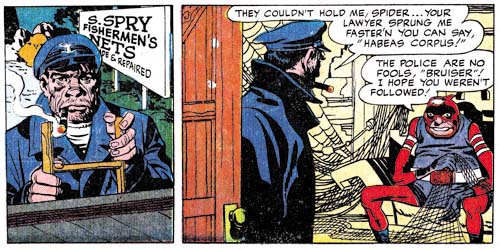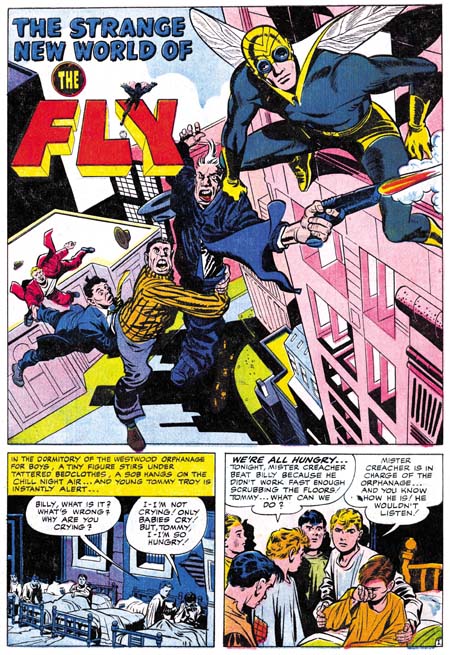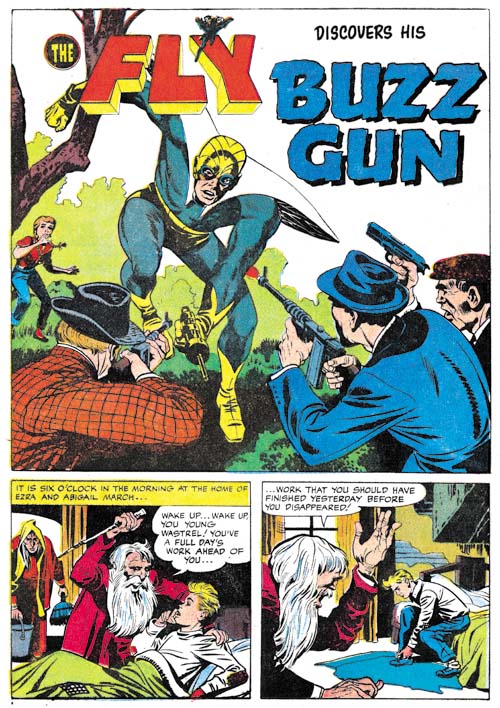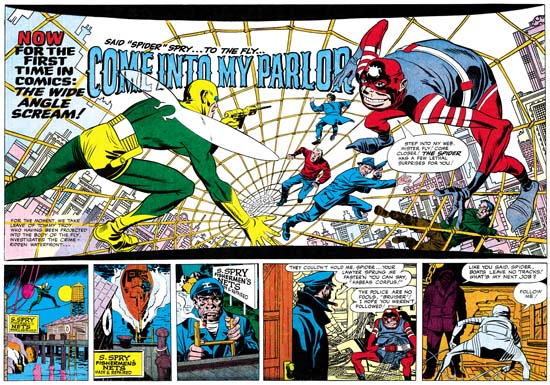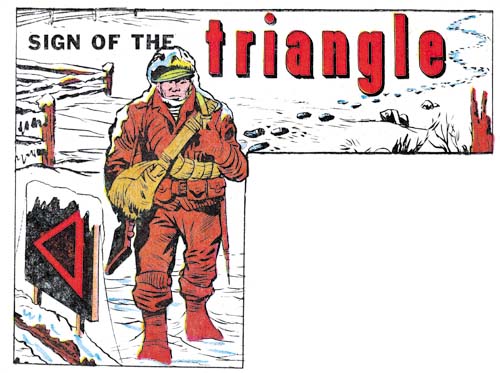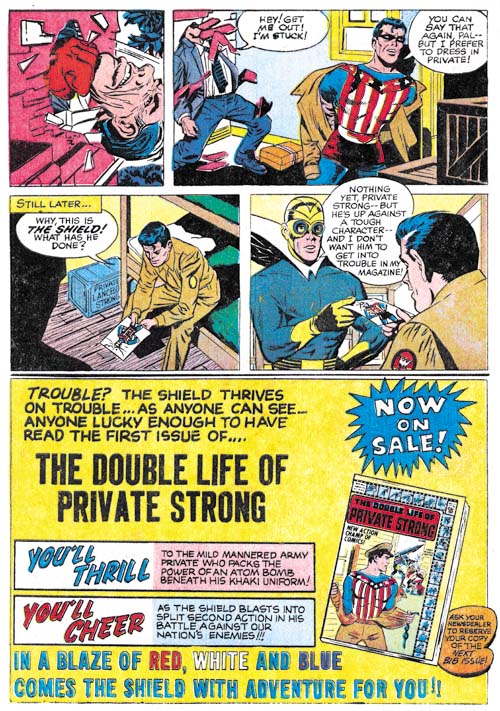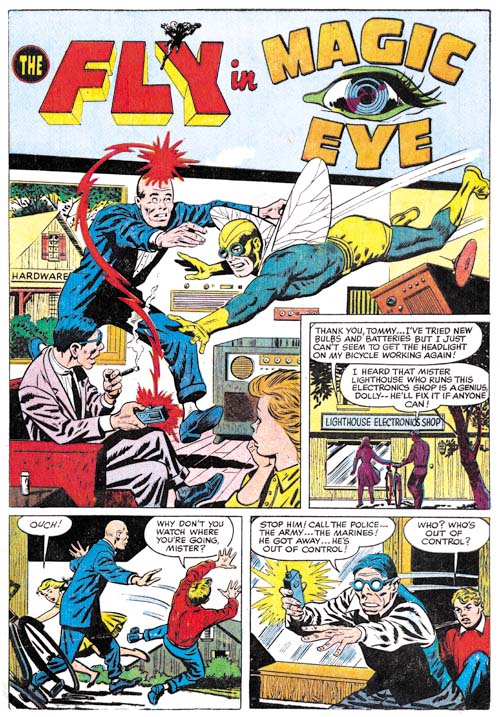This is the start of a new topic for the Simon and Kirby blog where I will write about original comic book art. This will not be a serial post where I would explore a subject over a number of posts. Instead each post will stand by itself with only the common theme of original art connecting them. There will be no order in what I write about and I will pick the particular subject as my mood suits me. Some of the pieces will be from my personal collection but most will be from the much more extensive collection that belonged to Joe Simon. I do that with the permission of the Joe Simon estate.
It is clear that many people, even comic book fans, really do not “get” original comic book art. But there is something very special about the original art as compared to the published comic books. It is not that the printing of the comic books was so bad (although that is certainly true) or that original art is unique while thousands of copies of a comic book may exist (but true again). What is truly special about the art is that it reveals the hand of the creators in ways that are simply not possible from the printed comic. There are nuances in things like inking that completely get lost in the production process. There are changes in the art that many people would consider blemishes but instead provide insight into the creative process. I remember a story about Joe Sinnott erasing margin notes because he thought it distracted from the art. Some original art have subject to extensive cleaning processes to remove all blemishes. I am sure this was done in an attempt to increase the value of the piece but to me it actually has quite the opposite effect. What may seem blemishes to some has an aesthetic quality for me. While aesthetics play an important roll in the value of original art, they have historical value as well.
Before writing about the original art for “One Of Our Skyscrapers Is Missing” by Al Williamson I would like to discuss a story that Joe Simon use to tell. Here it is as presented in his autobiography Joe Simon, My Life In Comics where he is talking about the Harvey Comics title Race For The Moon:
When I proposed the title, Jack welcomed the work. I wrote most of the stories, although Dick Wood, Dave Wood and Eddie Herron contributed some scripts. Because Kirby was penciling some of them, I was able to sign up three of the best inkers in the business. Reed Crandall, Angelo Torres, and Al Williamson, each of them a brilliant artist in his own right, all wanted to work with Jack. In addition to inking Jack’s pencils, they got to illustrate some stories on their own.
Although in his book Joe describes this story as concerning Race For The Moon, I remember Joe telling me that he heard about the story from something Williamson said. Williamson gave an interview for Jack Kirby Collector #15 where he discusses his work on Race For The Moon. I have written about Williamson’s comments in an recent post (Kirby Inkers, Al Williamson) but the what is important here is Williamson does not relate this story when talking about Race For The Moon. But in another part of the interview:
TJKC: You did a solo story for The Fly #2. How’d you get that job?
AL: I was asked by the editor, and he gave me a five-pager to do. I’d never done superhero stuff before, and I sat down and did this Jack Kirby-type character they wanted me to do. I penciled it and took it in, and the editor had a fit. “Aahh, you’re a lousy artist. This is no good.” I had to do the first two pages over again, and he paid me $45 for five pages of work. And when it came out, the only thing he’d changed was the splash, and he’d copied it from Jack. I was really pissed off. So dear old Angelo Torres gets a call from this guy, and he says, “I gave Williamson a job, and he’s a lousy artist, he can’t draw. I want you to do this four-page Fly story for me.” So Angelo went up and said, “Sure, I’ll do it.” Then he came over to the house and said, “Listen, Al. This guy said you can’t draw, you’re a lousy artist, and he wants me to do this four-page superhero thing, so I thought maybe I’d let you pencil it.” (laughter) So I did! I penciled the four pages, and gave it to Angelo, and he took it up. The editor looked at it and said, “See, this is great! You’re better than Williamson!” (laughter) So Angelo inked it, and the guy never knew I penciled it.
Clearly this is the same story but it concerns work for Adventures of the Fly #2. Williamson does not name the editor but it was Simon who put together the first four issues of Adventures of the Fly and he alone chose the artists and assigned the work.
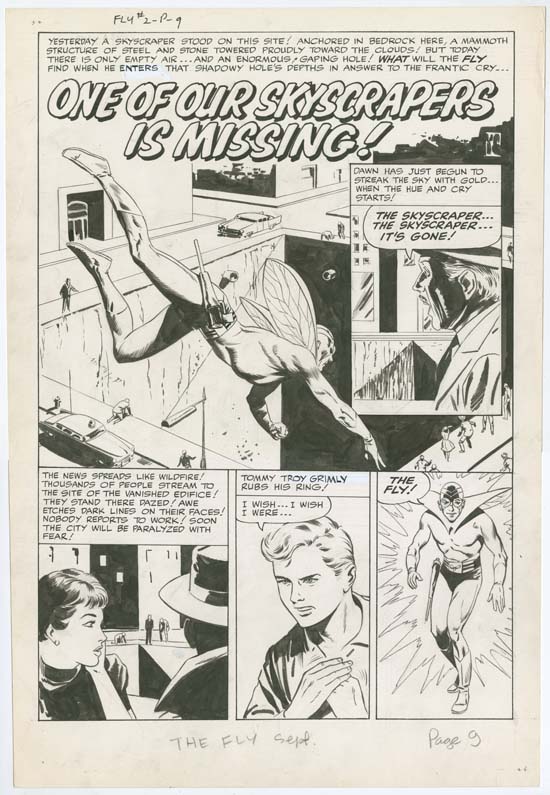
Adventures of the Fly #2 (September 1959) “One Of Our Skyscrapers Is Missing”, pencils by Al Williamson
In Williamson’s version of this tale he drew two stories for the issue. One that Joe was unhappy with and another drawn without Simon’s knowledge of his involvement. Williamson claims that Simon changed the splash of the first story but the rest was printed with no alterations. Williamson’s drawing style is very distinctive and there is no need for the original art to say with certainty that Williamson only drew one story for any issue of Adventures of the Fly. The drawing style alone would suggest that the splash for the story was pure Williamson. But the original art does conclusively shows that no changes were made to any of the art for this story, including the splash shown above. Any such changes would have to use white-out or other editing tools that would be completely obvious in the original art.
I have to say that I am rather dubious about another aspect of Williamson’s story, that Joe did not like his art. Simon used Al for inking Kirby pencils and for doing his own pencils for a number of Harvey comics for which Joe was the editor. While it is possible that Simon’s opinion changed just a couple of years later it would have to change again. When I knew him, Joe was a great admirer of Williamson’s art.
I suspect that the writing at the bottom of the page (present on the other pages as well) is a later addition. Usually the art was identified in ink in the upper left. In this case “FLY #2-P-9”, page 9 of issue 2 of Adventures of the Fly. It would remain on the proofs made when the art was shot for productions but could easily be removed before final printing. Occasionally someone forgot to remove them or did a poor job at it and they can be seen in part or whole in the printed comic books. This notation was done in ink to insure that it was still present when the initial stats were made. Pencils were problematic when photo imaging the original art to stats since they were not dark enough to insure a good image but too dark to be sure that they did not show up at all. Which is why pencils were erased after the inking was completed. While pencils notations like that at the bottom could easily be removed during the production process, they are redundant and do not serve any purpose.
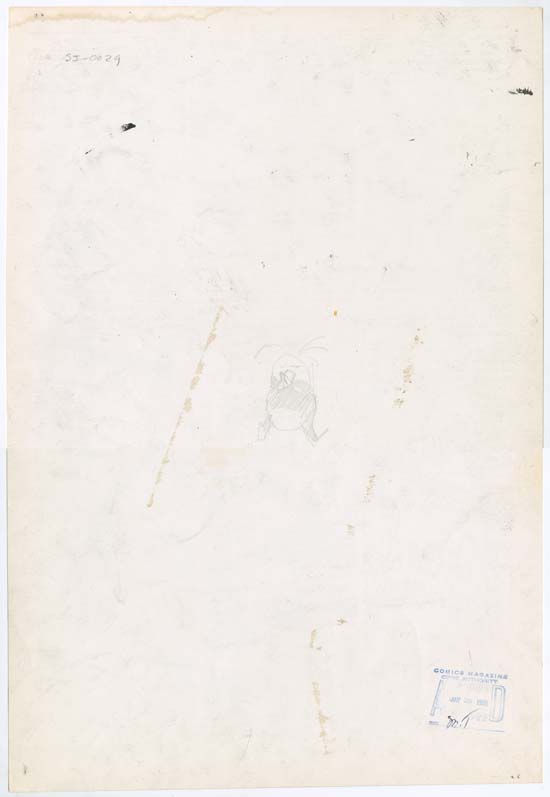
Adventures of the Fly #2 (September 1959) “One Of Our Skyscrapers Is Missing” the back of page 2
Sometimes rather interesting things can be found on the back of comic book art. However in the case of this story the back of the pages are pretty much unadorned. The only exception is page 2 which is shown above. An explanation is in order about the writing in pencil that reads SI-0029. This is the Simon Inventory number, and yes I am to blame. I did the inventory for Joe’s collection and it was a difficult task. Joe had over 1500 pages of original comic book art (not including many production proofs). I needed a way to keep track of it while the inventory was being created. So I assigned inventory numbers that I placed on the back usually near an edge and always in an area without anything significant. I suspect that for page 2 I placed the inventory number further from the edge because of the water stain. Inventory numbers were assigned as I inventoried the piece and have no significance other than order that I encountered them while working. There was one exception in that I generally assigned inventory numbers for original art to numbers less than 1000 and used the higher numbers for things like proofs. I also assigned the same inventory number to all pages belonging to the same story. This helped me in getting the collection better organized as originally pages to a story were often scattered about in different places.
Note the two small black irregular patches. I believe these to be due to the inker preparing his brush. Similar markings, although much more extensive, can be found on the back of other pages that I believed Williamson inked. However these two small marks are the only examples found on the back of this story or any other one that Joe had from the Adventures of the Fly title.

Adventures of the Fly #2 (September 1959) “One Of Our Skyscrapers Is Missing” close-up of the back of page 2
One thing that is common to backs of all the original art for this story, and indeed of most original art from the period, was the Comic Code approval stamp. Today the stamp is of use because it provides a terminal date for the creation of the art. Art could have started earlier, and even inventoried for a period of time, but the stamp was only applied to completed art ready for publication. Thus this art was finished no later than May 29, 1959. The same date appears for the approval stamp for “Marco’s Eyes”, “Tim O’Casey’s Wrecking Crew”, “The Master of Junk-Ri-La” and some of the fillers from the same issue. Comic book cover dates were used by the publisher to indicate when to take the issue off the stands and sent back to the distributor. When converting the cover date to the date the art was created I usually subtract five or six months. Two months for the time on the stands, one month for distribution, one month for printing and one month or more to create the art. From that scheme I would expect the approval stamp to be four months before the cover date. But it is just an estimate as there was much variations in the publication of comic books. For Adventures of the Fly #2 the stamp appears to be closer to three months before the cover date.

Adventures of the Fly #2 (September 1959) “One Of Our Skyscrapers Is Missing” close-up from back of page 2 of a Batman sketch by Al Williamson
The back of page 2 has one other feature that might be a little hard to make out in the full page image but when enlarged and rotated 180 degrees turns out to be a sketch of Batman. Obviously Batman would not appear in a Harvey comic book so it maybe nothing more than a doodle or a drawing done to demonstrate some point.


